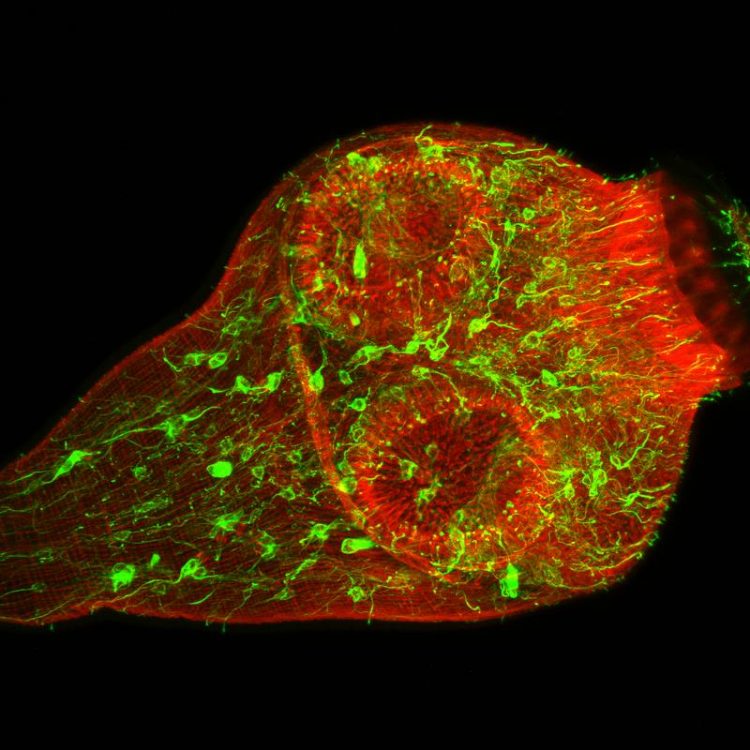Shedding light on tapeworms

Head of a fox tapeworm: The parasite attaches to the intestinal mucosa of its host by hooks and suckers. Special "kidney cells" that help to drain the head are dyed in green. (Image: Uriel Koziol)
Parasitic worms are a major problem worldwide, especially in developing countries. In tropical regions, for example, several million people are suffering from schistosomiasis. In the course of this infectious disease, worms damage the liver and other organs. They can even cause cancer.
Millions of people are infected with tapeworms. Particularly dangerous: dog and fox tapeworms. Their larvae form cysts in the tissue of the lung, liver or brain. These cysts proliferate or grow in the body much like tumours to reach a considerable size in some cases. In some species this can cause complications such as blindness and epilepsy, with others it may lead to death.
There have been no vaccines against these pathogens so far and only a very limited repertoire of drugs. Tapeworm cysts, for example, can only be kept in check with a lifelong chemotherapy. Once treatment is stopped, they will simply continue to grow. In Germany, around 50 people are infected with the fox tapeworm each year. This seems little compared to the figures worldwide, however, this is hardly a comfort to those affected.
Wellcome Trust funds research consortium
An international research consortium now wants to find new strategies to combat schistosomiasis and tapeworms. The Wellcome Trust, the UK's largest private funder of biomedical and veterinary research, supports the project: It promotes the “Flatworm Functional Genomics Initiative” with a Strategic Award worth five million euros. The project is set to start in late 2015 to run for five years.
Around 750,000 euros of the grant will be allocated to the team of Professor Klaus Brehm, a tapeworm expert, at the Institute of Hygiene and Microbiology of the University of Würzburg. The money is highly welcome, because: “We are far behind in our knowledge of worm parasites in infection research,” as Brehm puts it. He attributes this to the fact that the tapeworm genome was only recently mapped. Moreover, there are no methods available to analyse the worms' genetic functions in the lab. But this would be necessary to find potential targets for drugs or vaccines.
Investigating the worms' genetic functions
After all: The DNA of four tapeworm species was mapped in 2013. Brehm was involved in this work which was equally funded by the Wellcome Trust and was published in the journal “Nature”. “Now we have to develop methods to manipulate the worms' genes, because you have to be able to knock out a gene to understand its function.”
Brehm designates the venture as a “high-risk project”, meaning that it is so ambitious that the scientists could come out without a result after the project term. “But if we are successful, we will considerably advance the research in this field,” the Würzburg professor adds.
Perfectly camouflaged to hide from the immune system
The scientists are not only interested in new drugs and vaccines. They see another potential benefit in the tapeworm cysts: These dangerous structures are attached to the human body like perfectly transplanted organs; they cannot be harmed by the immune system.
“How do the worms manage to camouflage themselves so efficiently? Finding the answer to that question could mean progress for organ transplantation,” Brehm says. It is conceivable, for example, to disguise transplanted organs accordingly to protect them against the immune system's attack. The treatment of allergies and autoimmune diseases, too, could benefit from a better understanding of the strategies used by the worms to keep the immune system at bay.
The names of the project partners
The FUGI project (Flatworm Functional Genomics Initiative) is led by Professor Karl Hoffmann of the Aberysthwyth University in the UK.
Other partners are Matthew Berriman (Wellcome Trust Sanger Institute, UK), Ludovic Vallier (Cambridge University, UK), Professor Christoph Grunau (University of Perpignan and Centre National de la Recherche Scientifique, France), Professor Klaus Brehm (University of Würzburg, Germany), James Collins (University of Texas Southwestern Medical Center, USA), and Professor Paul Brindley (George Washington University, USA).
Nature publication on the tapeworm genome
“The genomes of four tapeworm species reveal adaptations to parasitism”, Nature 496, 57-63, 4. April 2013, DOI: 10.1038/nature12031
Contact
Prof. Dr. Klaus Brehm, Institut für Hygiene und Mikrobiologie, Universität Würzburg, phone +49 931 31-46168, kbrehm@hygiene.uni-wuerzburg.de
Media Contact
All latest news from the category: Life Sciences and Chemistry
Articles and reports from the Life Sciences and chemistry area deal with applied and basic research into modern biology, chemistry and human medicine.
Valuable information can be found on a range of life sciences fields including bacteriology, biochemistry, bionics, bioinformatics, biophysics, biotechnology, genetics, geobotany, human biology, marine biology, microbiology, molecular biology, cellular biology, zoology, bioinorganic chemistry, microchemistry and environmental chemistry.
Newest articles

NASA: Mystery of life’s handedness deepens
The mystery of why life uses molecules with specific orientations has deepened with a NASA-funded discovery that RNA — a key molecule thought to have potentially held the instructions for…

What are the effects of historic lithium mining on water quality?
Study reveals low levels of common contaminants but high levels of other elements in waters associated with an abandoned lithium mine. Lithium ore and mining waste from a historic lithium…

Quantum-inspired design boosts efficiency of heat-to-electricity conversion
Rice engineers take unconventional route to improving thermophotovoltaic systems. Researchers at Rice University have found a new way to improve a key element of thermophotovoltaic (TPV) systems, which convert heat…



